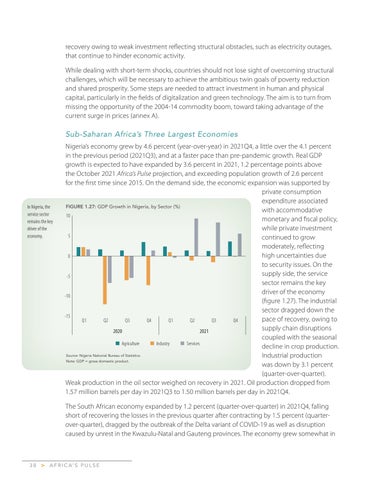recovery owing to weak investment reflecting structural obstacles, such as electricity outages, that continue to hinder economic activity. While dealing with short-term shocks, countries should not lose sight of overcoming structural challenges, which will be necessary to achieve the ambitious twin goals of poverty reduction and shared prosperity. Some steps are needed to attract investment in human and physical capital, particularly in the fields of digitalization and green technology. The aim is to turn from missing the opportunity of the 2004-14 commodity boom, toward taking advantage of the current surge in prices (annex A).
Sub-Saharan Africa’s Three Largest Economies
In Nigeria, the service sector remains the key driver of the economy.
Nigeria’s economy grew by 4.6 percent (year-over-year) in 2021Q4, a little over the 4.1 percent in the previous period (2021Q3), and at a faster pace than pre-pandemic growth. Real GDP growth is expected to have expanded by 3.6 percent in 2021, 1.2 percentage points above the October 2021 Africa’s Pulse projection, and exceeding population growth of 2.6 percent for the first time since 2015. On the demand side, the economic expansion was supported by private consumption expenditure associated FIGURE 1.27: GDP Growth in Nigeria, by Sector (%) with accommodative 10 monetary and fiscal policy, while private investment 5 continued to grow moderately, reflecting high uncertainties due 0 to security issues. On the supply side, the service -5 sector remains the key driver of the economy -10 (figure 1.27). The industrial sector dragged down the -15 pace of recovery, owing to Q1 Q2 Q3 Q4 Q1 Q2 Q3 Q4 supply chain disruptions 2020 2021 coupled with the seasonal Agriculture Industry Services decline in crop production. Source: Nigeria National Bureau of Statistics. Industrial production Note: GDP = gross domestic product. was down by 3.1 percent (quarter-over-quarter). Weak production in the oil sector weighed on recovery in 2021. Oil production dropped from 1.57 million barrels per day in 2021Q3 to 1.50 million barrels per day in 2021Q4. The South African economy expanded by 1.2 percent (quarter-over-quarter) in 2021Q4, falling short of recovering the losses in the previous quarter after contracting by 1.5 percent (quarterover-quarter), dragged by the outbreak of the Delta variant of COVID-19 as well as disruption caused by unrest in the Kwazulu-Natal and Gauteng provinces. The economy grew somewhat in
38
>
A F R I C A’ S P U L S E

